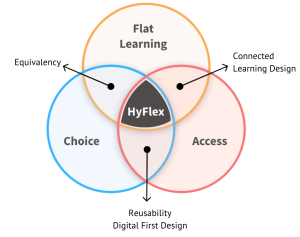Approaches to Learning
Reflection
Attributes in context
Now that you have explored the three attributes of HyFlex learning, let’s discuss interpretation and relevance to your context.
Here is the diagram we created earlier sharing the relationships between HyFlex attributes and principles.

Use these questions as prompts for discussion with your peers:
- How do the three attributes (choice, flat learning and accessibility) apply or could apply in your context?
- What are some challenges with implementing designs that cater for choice?
- What are the features and challenges of a flat learning and teaching approach?
- What are challenges with accessibility?
- What examples can you share of these attributes being used in your learning environment?
- How do you see the interconnectedness of the attributes with equivalence and reusability?
- If you were to draw a contextual relationship diagram of the attributes and principles, what would that look like? Why?
Consider your online learning challenges/problems and your context in terms of your students and teachers.
- How HyFlex are your current approaches?
- Do you currently design learning in a ‘digital-first’ mode?
- How do you/would you develop relationships between synchronous and asynchronous learning?
- Is HyFlex the ‘magic bullet’ for how we design and implement learning now? Does it meet the needs of your context?
This is an important area for you to formulate initial ideas about HyFlex learning based on evidence from your institution/context/beliefs/practices.
Media Attributions
- HyFlex model: three attributes © University of Southern Queensland is licensed under a CC BY-NC (Attribution NonCommercial) license

